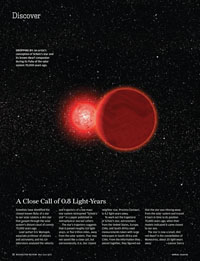 DROPPING BY: An artist’s conception of Scholz’s star and its brown dwarf companion during its flyby of the solar system 70,000 years ago. (Photo: Michael Osadciw)
DROPPING BY: An artist’s conception of Scholz’s star and its brown dwarf companion during its flyby of the solar system 70,000 years ago. (Photo: Michael Osadciw)Scientists have identified the closest known flyby of a star to our solar system: a dim star that passed through the solar system’s distant cloud of comets 70,000 years ago.
Lead author Eric Mamajek, associate professor of physics and astronomy, and his collaborators analyzed the velocity and trajectory of a low-mass star system nicknamed “Scholz’s star” in a paper published in Astrophysical Journal Letters.
The star’s trajectory suggests that it passed roughly 0.8 light-years, or five trillion miles, away from the solar system. That may not sound like a close call, but astronomically, it is. Our closest neighbor star, Proxima Centauri, is 4.2 light-years away.
To work out the trajectory of Scholz’s star, astronomers from the United States, Europe, Chile, and South Africa used measurements taken with large telescopes in South Africa and Chile. From the information they pieced together, they figured out that the star was moving away from the solar system and traced it back in time to its position 70,000 years ago, when their models indicated it came closest to our sun.
The star is now a small, dim red dwarf in the constellation of Monoceros, about 20 light-years away. —Leonor Sierra
Water Cooler Trumps Tweets
Watching a television program isn’t what it used to be. In the era of social media and streaming, viewers don’t gather around the water cooler at the office to discuss plot twists and turns in a favorite program broadcast the night before.
Or do they?
New research from the Simon Business School suggests that social media don’t rule the tube and word-of-mouth still holds more influence over viewers.
While social media—especially Twitter—can benefit a show in real time, word-of-mouth has greater power to influence a person to watch a new program.
The study—by Mitchell Lovett, associate professor of marketing, and colleague Renana Peres at Hebrew University of Jerusalem—comes out of a collaboration between the pair and the Keller Fay Group, a marketing research company, and the Council for Research Excellence.
They found that for both regular and infrequent viewers of a program, offline word-of-mouth communication most strongly influences viewing.
For those who watch infrequently, social media communications are more influential than promotions, but for repeat viewers, the opposite is true.
—Charla Kucko
Dangers Found in E-Cigarettes
While a debate goes on about whether electronic cigarettes help people quit smoking, new research suggests that e-cigarettes are likely a toxic replacement for tobacco.
According to the study led by Irfan Rahman, professor of environmental medicine, and published in the journal PLOS One, emissions from e-cigarette aerosols and flavorings damage lung cells by creating harmful free radicals and inflammation in lung tissue. The investigation suggests that harm begins when the e-cigarette’s heating element is activated, turning a liquid solution into an aerosol that mimics cigarette smoke. The inhaled vapors contain heavy metals and other possible carcinogens in the form of nanoparticles.
“Several leading medical groups, organizations, and scientists are concerned about the lack of restrictions and regulations for e-cigarettes,” says Rahman, adding that his group’s research affirms that e-cigarettes pose significant health risks and should be investigated further.
The biggest concern is for users under age 18. E-liquid flavorings marketed to kids and teens include fruit, dessert, and candy, and are widely available in convenience stores, gas stations, and online. Sales in the United States are estimated to exceed $1 billion. —Leslie Orr
Inventors Make a Protean Production
Although most materials slightly expand when heated, a new class of rubber-like material not only self-stretches upon cooling, but also reverts back to its original shape when heated—all without any physical manipulation.
Mitchell Anthamatten, associate professor of chemical engineering, led development of the material, which can be switched between two different shapes—and is distinctive because the shape changes occur without altering any external factors besides heat.
The research was published in the journal ACS Macro Letters.
Anthamatten and his team built on the success of a recently developed polymer that can also stretch when cooled.
The other polymers rely on small weights to direct them in taking new shapes. That’s not the case with the Rochester polymer because the team built a network of molecules in the polymer to create permanent stress inside the material, which “tricked” the polymer into acting as if weights were attached.
The stress enables the material to “remember” the shape it will assume when it’s later cooled.
Anthamatten envisions the material being applied to areas in which reversible shape-changes are needed, such as biotechnology, artificial muscles, and robotics.
—Peter Iglinski

